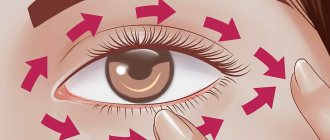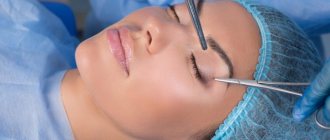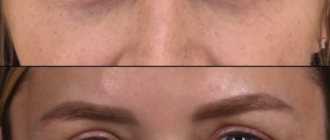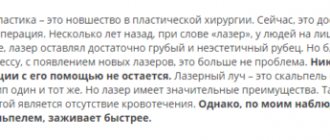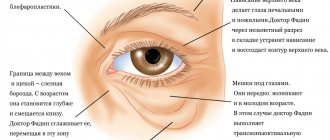Consultation with plastic surgeons with over 20 years of experience – free! Sign up by phone. Waiting for you! The impact of the environment and the internal processes of aging of the body primarily affect the condition of the delicate skin of the eyelids. Drooping of the outer corners of the eyes, ptosis of the skin of the upper eyelids form bags under the eyes. This gives the face a tired look and also inevitably adds age. Blepharoplasty of the lower eyelids may also be indicated for medical reasons due to vision problems.
Indications for surgery
Typically, blepharoplasty is performed on middle-aged and older patients in order to correct age-related changes and make the look youthful and open. Main indications:
- bags and hernias under the eyes, in the lower eyelids.
- pronounced signs of aging: deep wrinkles, folds;
- undesirable anatomical features (for example, lack of volume, thin skin and translucent vessels).
Plastic surgery can significantly improve the overall appearance. After the intervention, your eyes become larger, your gaze becomes wide-open - even if you are not planning additional anti-age procedures, correction of the periorbital area will help you take off several years.
The effect is especially noticeable if the patient’s main problem was fatty hernias of the lower eyelids (popularly called “bags”). Excess fat tissue in this area makes the face tired and gloomy. By getting rid of excess, you can noticeably refresh your face as a whole. Blepharoplasty can also be combined with other types of surgical interventions (for example, correction of the chin and neck area, circular lift). In this case, the rejuvenating effect will be most pronounced.
Types and methods of plastic surgery
Eyelid surgery is performed using several methods, each of which has its own characteristics. The main goal of the intervention is to strengthen muscle structures, redistribute fatty tissue located under the skin of the eyelids.
Classic method
Surgical blepharoplasty involves removing excess skin and fatty tissue through a thin incision along the edge of the lower eyelids. Excess skin in the eyelid area is excised, the wound is sutured with special suture material - after healing, a thin, almost invisible scar remains.
Transconjunctival method
In this case, access to the subcutaneous fat is achieved through micro-incisions in the conjunctiva. The surgeon removes excess eyelid tissue in the amount that was determined before the intervention, or redistributes it if necessary. A wound on the mucous membrane after plastic surgery does not need to be sutured; this is done only in rare cases. The patient is given a pressure bandage for several hours.
This method is considered gentle, but it has limitations - if a large amount of tissue needs to be excised, transconjunctival blepharoplasty will not be suitable.
Surgery with canthopexy
In this case, plastic surgery is performed with a change in the shape of the eyes - the outer edge of the eyelids is lifted. Canthopexy can also be performed separately if the patient is not satisfied with the “sad” shape of the eyes with drooping corners, and there are no visible defects under the eyes.
Laser method
A modern, low-traumatic method that does not involve surgical incisions in the skin of the eyelids. The impact on tissue is carried out with a laser beam. Penetrating deep into the tissue, the laser causes microdamage to it. As a result, regeneration processes are activated in the skin, collagen and elastin begin to be actively produced. The result is denser, more elastic and tightened skin of the lower eyelids.
We actively use this method, primarily because it allows us to achieve excellent results without wounds or noticeable damage to the skin of the eyelids. Laser plastic surgery of the lower eyelids does not leave any scars; it has a very short rehabilitation period—in just one and a half to two weeks, the patient will be able to evaluate the changes that have occurred and return to their normal lifestyle. The price of such an intervention is higher than the cost of a classic operation, but it has significant advantages, and many choose this route.
Methods of lower eyelid blepharoplasty
There are two ways to perform blepharoplasty:
- Classic lower eyelid surgery
When performing classic lower eyelid surgery, the incision is made along the natural folds, slightly away from the eyelash edge. This manipulation is necessary in order to open access to the localization of fat packets, to the orbicularis oculi muscle. Next, the surgeon delicately peels the skin away from the muscle and removes or redistributes the fatty hernias. If necessary, excess skin is excised. At the end of the operation, a cosmetic suture is placed on the incision area. During surgery, canthopexy is often performed to prevent cicatricial ectropion of the lower eyelid after blepharoplasty. This is required in particular for those patients who have a flabby eyelid edge.
The duration of the entire operation for lower eyelid blepharoplasty is about 1 hour.
Excision of the skin can also be carried out with a laser, but its use in the eye area is not recommended by many specialists
- Transconjunctival lower eyelid surgery
The transconjunctival method is most often indicated for young patients with slight excess skin of the lower eyelids. Transconjunctival blepharoplasty requires good, tight and elastic skin. The ideal patient is a young man or woman who does not have age-related changes, but has persistent and persistent bags under the eyes or swelling.
The advantage of the operation is that it is performed without an external incision. Access is through an incision or puncture in the conjunctiva of the eye. Then, excess fatty tissue is removed. No stitches are required as the mucous membrane heals very quickly. The operation also lasts about 1 hour. Read more about this technique here.
Gvaramia A.A. comments:
“Having performed eyelid surgery for more than 20 years, I can say with confidence that there is nothing better than a scalpel for this operation. I'm talking specifically about the skin incision. This is what I and most of my colleagues think. If a laser or radio knife is used, small vessels are “welded”: this is convenient for the surgeon, since the wound does not bleed. But this affects the quality of the scar! And for the best scar, I prefer a scalpel. The laser is a wonderful device, but its use must be appropriate in aesthetic medicine. Its use is justified in the transconjunctival technique, since the incision passes through the mucosa. But the final result in this case is not affected in any way by what exactly the doctor used to make the incision: it is solely a matter of the surgeon’s comfort.”
What result should I expect?
It all depends on the nature of the problem. If you were unhappy with the presence of bags under your eyes, lower eyelid surgery will eliminate this defect completely. If the problem was deep folds or a pronounced tear trough, eyelid skin tightening can be combined with lipofilling - the relief will be leveled, the skin will become more elastic and dense.
Blepharoplasty with canthopexy will lift the outer edges of the eyes - the face will look more fresh and joyful (subconsciously drooping edges of the eyes are perceived as a sign of sadness).
Cost of lower blepharoplasty
RUB 51,000
Make an appointment
Preparation for the procedure
Everything will depend on the method the doctor chooses. Laser blepharoplasty is considered a low-traumatic intervention. It is performed on an outpatient basis, it has a minimum of contraindications and practically does not cause discomfort. No special training is required either.
If you need classic blepharoplasty (using a scalpel), the preparation will be the same as for any other operation. You will need to undergo general clinical tests (blood and urine), a blood coagulogram (to determine if there are any problems with clotting), and an ECG. Such interventions are performed under general anesthesia, and the doctor must be informed about all your chronic diseases and medications you are taking, if you are allergic to any medications, etc.
Before the operation (about 8 hours) you will need to refuse food. There should be no wounds or damage in the lower eyelid area. Blepharoplasty is also not performed if there are signs of allergies (itching, redness of the eyes).
How is the operation performed?
- Through an incision in the skin of the eyelids or on the mucous membrane, the doctor gains access to the area of interest, separates and excises excess skin and fatty tissue. If blepharoplasty was performed percutaneously, a thin suture is applied to the lower eyelid area.
- When accessing through the mucosa, sutures are usually not applied. In both cases, the patient can return home on the same day of surgery.
Laser plastic surgery is performed under local anesthesia. The patient's eyes are covered with special protective lenses before treatment begins. This makes it possible to get as close to the eyelash edge as possible without risk. Using a special attachment, the doctor will treat the problem area, and on the same day the patient will be able to return to their usual activities.
Types of anesthesia
Many people believe that an anesthesiologist is someone close in importance to a nurse: he handed over a mask, counted something and stepped aside. But this is not true. It is this specialist, after examining and studying your data, who makes the decision on what type of anesthesia to use for the operation.
During the procedure, he monitors the patient's condition. And can stop surgery if vital signs change.
What kind of anesthesia is there?
- Local
With local anesthesia, an anesthetic is injected directly into the surgical site.
This type is used for minor surgical operations.
Local anesthesia does not always require an anesthesiologist. A surgeon can also perform it.
2. Regional
This type of anesthesia is performed strictly only by an anesthesiologist.
The anesthetic is injected in the same way as in the case of local anesthesia into the intervention area.
The patient may remain conscious. However, to facilitate the procedure, he is given a sedative. The man falls asleep.
Regional anesthesia can be:
- Spinal
- Epidural.
It is widely used in urological, gynecological and orthopedic surgeries.
3. General (anesthesia)
Many people have heard the term “local anesthesia”. This misconception arose from the very vague understanding of ordinary people about operating procedures.
Anesthesia is general anesthesia, which involves turning off the patient’s consciousness during the operation using intravenous or inhalational anesthetics.
The patient breathes through an endotracheal tube inserted into the trachea.
After the operation, the administration of the anesthetic is stopped, the patient begins to breathe independently, and the tube is removed.
All these processes occur under the control of an anesthesiologist.
Rehabilitation after blepharoplasty
After the operation is completed, the doctor applies a sterile bandage to the lower eyelid area. Sutures, if the access was percutaneous, are usually removed within 4-5 days. Immediately after blepharoplasty and for a few more days, you will need to observe certain restrictions.
Firstly, they relate to physical activity: you cannot play sports or do hard work. It is undesirable to sleep on your stomach and lean forward - this can cause severe swelling in the lower eyelid area. Activities that require visual stress should be avoided for about two weeks. It is also not recommended to go out in the sun without sunglasses.
After about 4 days, you will need to come in for an examination with a surgeon so that he can assess how the healing process is going. Thin crusts form in the area of the incisions - you need to be as careful as possible with them. They should not be rubbed, combed or wet - this can lead to infection of the wound. You also cannot use cosmetics. During the first days, the eyelid skin should be treated with antiseptics.
Recovery period after surgery
Sutures after blepharoplasty are not removed, as special absorbable threads are used.
In the first days after surgery, swelling is observed: this is a natural reaction of the body. Swelling can be reduced by applying cold compresses.
Patients must also adhere to certain rules for speedy rehabilitation after blepharoplasty:
- eliminate stress on the eyes and eyelids (reading, computer, TV, contact lenses, bright light);
- give up smoking and alcohol (to avoid major swelling), and salty foods;
- sleep only on your back using a high pillow;
- replace contact lenses with glasses for a month;
- try not to tilt your head;
- protect eyelids and eyes from external influences (wind, bright light, cosmetics, soap);
- wash your face with chamomile decoction;
- avoid baths and saunas;
- carefully perform special eye exercises.
The rehabilitation period lasts from 7 to 10 days. A person can return to work after 2 weeks. The result will be noticeable immediately after the operation, but the final effect will become obvious only after a month. Following the rules of eyelid skin care will allow you to preserve it for as long as possible, sometimes this period is more than ten years.
Contraindications
Blepharoplasty is not performed for people with severe endocrine diseases, chronic diseases of the cardiovascular system, or bleeding disorders. Also, the operation cannot be performed if the patient has a tendency to form keloid scars or eye diseases (conjunctivitis, blepharitis, dry eye syndrome, etc.).
To find out the price for eyelid surgery in our clinic in Moscow, call us or leave a request on the website. Our specialists will promptly contact you and schedule a consultation.
What is laser blepharoplasty
In our clinic, the innovative laser device FOTONA SP Dynamis is successfully used for 4D rejuvenation of the skin of the eyelids and area around the eyes for non-surgical blepharoplasty. The equipment is unique - it has no analogues on the modern aesthetic medicine market. This is explained by the fact that the device body combines two systems at once - erbium (Er:YAG) and neodymium (Nd:YAG) lasers.
The idea behind the Fotona SmoothEye procedure is brilliant, simple and very smart: strengthen the upper eyelid muscle, not cut it out!!! And you can get rid of excess skin without incisions and long recovery.
The essence of non-surgical blepharoplasty is a four- or five-stage treatment of not only the skin of the eyelids, but also the entire upper third of the face, including treatment of the eyelids from the inside - from the side of the conjunctiva. To do this, several laser technologies are used sequentially, during one procedure.
The effect of laser causes the effect of biorevitalization of tissues of the periorbital area. After circular laser blepharoplasty, powerful rejuvenating processes are launched in the eyelids and skin around the eyes. Old collagen fibers are reduced and new ones are formed. Intercellular connections are restored, the production of hyaluronic acid increases. The skin flap is reduced.
The result is a noticeable tightening, smoothing and rejuvenation of the skin of the eyelids and upper face. In most cases, a course of such procedures replaces the need for a plastic surgeon and circumcision of heavy eyelids.
